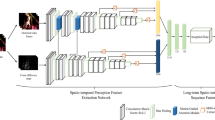Abstract
The reduced-reference video quality evaluation method uses only partial reference video information to evaluate the quality of deteriorated videos. This method can evaluate the quality of a video in real-time because less transmission bandwidth is required. Because the video active area attracts significant human eye attention, any deterioration in the active area will directly affect video evaluation results. Given the advantage of reduced reference model in VQM (Video Qualify Metric), this paper proposes a reduced reference evaluation model named RR-PEVQ (Reduced Reference Perceptual Evaluation of Video Quality) for weighting the active video area. According to the experimental results, the RR-PEVQ evaluation score is similar to that of the full reference PEVQ and the proposed method’s practicability is greatly improved for big data purposes.



Similar content being viewed by others
References
Brunnstrom K, Hands D (2009, May) VQEG validation and ITU standardization of objective perceptual video quality metrices[J]. IEEE Signal Proc Mag [96]
Bughin J, Chui M, Manyika J (2010) Clouds, big data, and smart assets: ten tech-enabled business trends to watch. McKinsey Quarterly 56(1):75–86
Chen W-M, Lai C-J, Wang H-C, Chao H-C, Lo C-H (2011) H.264 video watermarking with secret image sharing. IET Image Process 5(4):349–354
Cheng R-S, Lin C-H, Chen J-L, Chao H-C (2012) Improving transmission quality of MPEG video stream by SCTP multi-streaming and differential RED. J Supercomput 62(1):68–83
Feng C (2010) Image quality assessment-oriented frame capture of video phone over 3G system; Anti-counterfeiting, Security and Identification, p 359–362
Gao X-B (2010) Quality assessment methods for visual information. XiDian University Publishing House, Xi’an
Hsu T-H, Liang Y-S (2011) Enabling adaptive video streaming for BitTorrent-like video systems. J Internet Technol 12(5):813–824
ITU-R Recommendation BT.500-11 (2002) Methodology for the subjective assessment of the quality of television pictures. International Telecommunication Union, Geneva, Switzerland
ITU-T Recommendation J.244 (2008) Full reference and reduced reference calibration methods for video transmission systems with constant misalignment of spatial and temporal domains with constant gain and offset [S]
ITU-T Recommendation J.247 (2008) Objective perceptual multimedia video quality measurement in the presence of a full reference. International Telecommunication Union, Geneva, Switzerland
Ma G, Yang J, Zhou B (2008) Motion detection in video based on YUV color space [J]. Comput Eng Des 7.Vol 29
Meng F, Jiang X, Sun H, Yang S (2007) Objective perceptual video quality measurement using a foveation-based reduced reference algorithm, 2007 I.E. International Conference on Multimedia and Expo, Beijing, China, July 2–5
Pinson MH, Wolf S (2004) A new standardized method for objectively. IEEE Trans Broadcast 50(3):312–322
Video material. [On line]. Available: http://vqa.como.polimi.it/
Wu T-Y, Chen C-Y, Kuo L-S, Lee W-T, Chao H-C (2012) Cloud-based image processing system with priority-based data distribution mechanism. Comput Commun 35(15):1809–1818
Zhou L, Chen M, Zhiwen Y, Rodrigues J, Chao H-C (2010) Cross-layer wireless video adaptation: tradeoff between distortion and delay. Comput Commun 33(14):1615–1622
Acknowledgments
The work presented in this paper was partially supported by 2011 National Natural Science Foundation of China (Grant number 61172097), 2012 Natural Science Foundation of Fujian (Grant number 2012J01424), NCETFJ, Fundamental Research Funds for the Central Universities (2012121028), and NSFC (61271242,61001072), Natural Science Foundation of Fujian Province of China (No.2010J01347), SRF for ROCS, SEM.
This research is supported by the Comba fund.
Author information
Authors and Affiliations
Corresponding author
Rights and permissions
About this article
Cite this article
Xu, WJ., Zhao, CD., Chiang, HP. et al. The RR-PEVQ algorithm research based on active area detection for big data applications. Multimed Tools Appl 74, 3507–3520 (2015). https://doi.org/10.1007/s11042-014-1903-8
Published:
Issue Date:
DOI: https://doi.org/10.1007/s11042-014-1903-8




